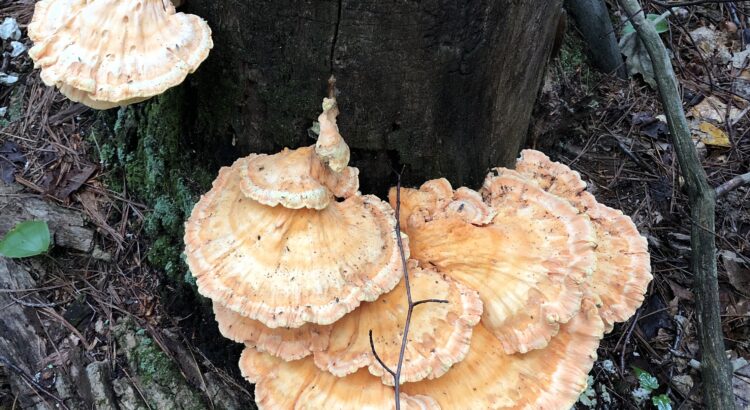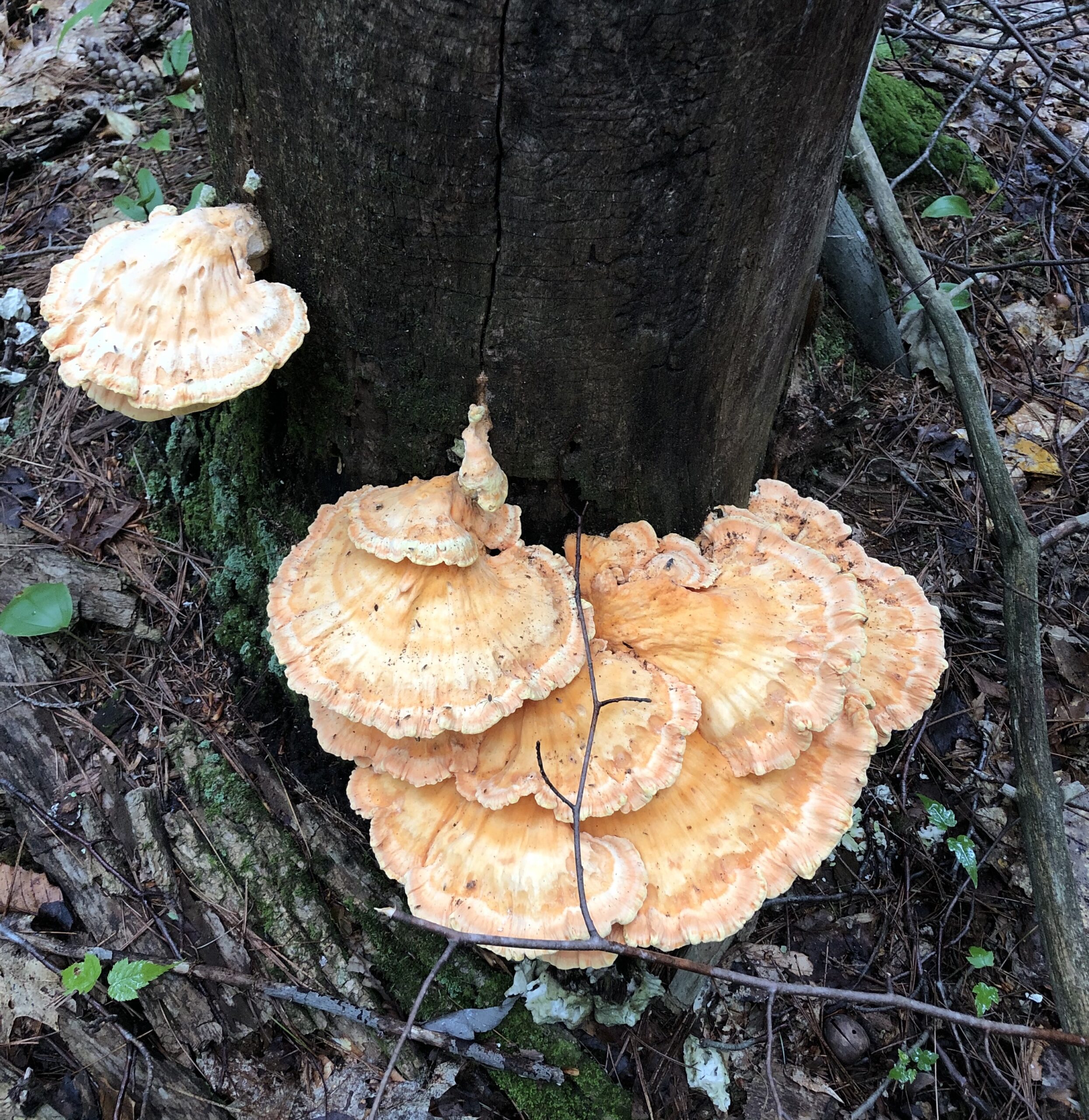
Joy Wetzel, SCA Interpretive Ranger
I had a wonderful day last week! While traveling through Monadnock State Park after a day of delivering Discover the Power of Parks (DPP) educational programs, I caught a flash of orange at the base of a dead tree that made me do a double-take. A second glance confirmed my suspicions: I’d spotted a Chicken of the Woods mushroom, something that, despite my best efforts, I hadn’t come across since 2020. I had heard rumors from other park employees that they grow at the park, but I did not think I would be lucky enough to find one. Almost giggling with excitement, I quickly harvested it with my pocketknife and brought it home for dinner. For someone unfamiliar with the practice of foraging, this reaction could seem a little bizarre, scary, or even downright gross. Today, I’ll be sharing with you why I love foraging, and why you should, too.
Before I speak more on this mushroom, I feel obliged to add a disclaimer. I cannot emphasize enough the importance of one hundred percent certainty when consuming wild mushrooms!!! I have been foraging for over a decade, and I only feel safe harvesting and eating about five mushroom species. This is because mistakenly consuming the wrong mushroom can be deadly, and one must always forage with an abundance of caution. However, if you are new to foraging, please do not feel discouraged! Later in this post, I recommend resources that can get you started on your mushroom foraging journey.
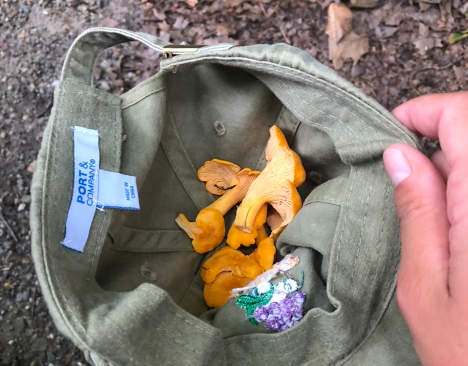
What is foraging?
Foraging is the process of searching for resources from the natural environment. Most Americans purchase all of our food at grocery stores or—if we have the resources, farmer’s markets. Few people in this country have the opportunity to watch their food grow or harvest it directly from its source. Finding and consuming resources grown independently from human intervention can be an incredibly special experience. For those who have experienced food insecurity, it can even be empowering. Here are some other reasons to consider taking up foraging as a hobby:
- It’s free. This is the main reason I did so much foraging in college. You go on a walk, and you get a free dinner.
- Connect with the past. Humans have practiced agriculture for only a brief part of our time on Earth. Before that, hunting and gathering was the only way people found sustenance. In the far less distant past, New Hampshire’s Abenaki people practiced a sustainable combination of agriculture and foraging that kept them closely linked to their land. We still occupy their unceded territory today.
- Connect with your surroundings. Learning about one wild edible requires learning about its entire ecosystem. You’ll find yourself developing a relationship with the natural world as you begin to navigate it more and more.
- Learn patience. It’s not often that you find a massive batch of wild edibles in one place. Foraging is a long and meditative process. I spent a lot of time doing it a few years ago while dealing with some emotional strife. The process of wandering the forest in search of mushrooms, even when those expeditions weren’t fruitful, helped me perform some necessary soul-searching.
- Try new things. The forest is full of flavors beyond the scope of your imagination. I have several friends who despised mushrooms until they tried foraged ones and realized that the white button mushrooms available at the grocery store represent just one of hundreds of edible species.
Foraging is not exclusive to food—people also forage for things like medicine or even arts and crafts. For the sake of this article am focusing on mushrooms, but you can also develop skills foraging for leaves, roots, berries, nuts, and seeds.

Getting Started
As I mentioned earlier, foraging for mushrooms is a hobby that requires performing a lot of research. As a first step, I always recommend purchasing a field guide. I personally use the National Audubon Society Field Guide to North American Mushrooms, which contains colored photographs of over 500 mushroom varieties, along with detailed descriptions and a glossary. It can also help to join local mushroom foraging Facebook groups to meet other foragers and receive second opinions on identification. I’ve had nothing but positive experiences in these kinds of groups and have learned a lot from them very quickly.
Before you begin worrying about finding mushrooms to eat, spend some time practicing ID with your guidebook. Over time, you’ll find it easier to spot the differences between a gill and a false gill, a universal veil from a partial veil, and more. This will prevent you from making dangerous mistakes later on. When you do start looking for mushrooms to eat, go with just one variety in mind, preferably one with no dangerous lookalikes. I started with chanterelle mushrooms. Only consume something if you’ve received a positive ID from multiple sources, including several experienced foragers. If ever in doubt, don’t eat it!
Ethical foraging
Foraging has become increasingly popular with Americans in the past few years, especially since more and more social media influencers such as Alexis Nikole Nelson have begun sharing their extensive foraging knowledge. That’s a great thing! However, it also means more and more people are seeking out a limited resource, increasing our need to consider the ethics of foraging. Here are some general rules of thumb I follow to ensure that my mushrooming practice is sustainable and ethical. You’ll notice that there are quite a few overlaps between these and the principles of Leave No Trace.
- Come prepared. If you fail to prioritize your own health and safety, you’ll be unable care for the spaces you’re entering. Check the weather forecast, stay hydrated, and pay attention to hazards. The EMT’s who’ll have to rescue you, otherwise, won’t be particularly concerned with not trampling your finds.
- Keep foraging spots to yourself. Sharing is caring, but letting others (especially on the internet) know about good foraging spots can lead to overcrowding that will damage natural areas.
- Respect the law. Pay attention to where you can and cannot legally forage. No law directly prohibits foraging in New Hampshire’s state parks, but this is not the case in many state and national parks across the country.
- Respect the natural areas you’re entering. Mushrooms rely on their ecosystems, and their ecosystems rely on them. Pack out any waste (this includes food waste!). Do not tread on other habitats in order to reach what you want.
- Leave things behind. Try to take just what you need, leaving enough for the mushrooms to continue reproducing—and for other foragers to find. Remember, people aren’t the only creatures in the forest who love mushrooms! Avoid harvesting immature or “pinhead” mushrooms so they have the chance to grow further and release their spores.
- Don’t sell what you find. Consider your findings gifts from nature. Not everything needs to be monetized.
I think it is also important to note that you are only removing the fruiting body of a mushroom when you harvest it, not the mycelium that grows underground or in other organisms. This is quite different from doing something like uprooting an entire blueberry bush.
How to ID the Chicken of the Woods
Now that you have some general information about mushroom foraging, let’s learn a little bit more about the Chicken of the Woods. It is not to be mistaken with the Hen of the Woods or the Rooster of the Woods, two completely different mushrooms! This mushroom, often abbreviated to COW or referred to as the Chicken Mushroom or Sulphur Shelf, has its name for a reason. The COW has a unique flavor and stringy texture that makes it resemble chicken. For this reason, foragers consider it a highly-desirable “choice edible.” Many people also consider it one of the easier edible mushrooms for beginners to forage, because it has less dangerous lookalikes than, say, the chanterelle mushroom. It has two edible varieties—Laetiporus Sulphureus and Laetiporus Cincinnatus. The former has a yellow underside, while the latter has a white underside. The one I found last week was a Laetiporus Sulphureus.
Fungi feed on organic matter. They’re not plants. In fact, in many ways, mushrooms more closely resemble animals than they do plants. The COW is a parasitic mushroom—found on either dead or living hardwood trees. Until it uses up its food source (i.e., the tree), a Chicken of the Woods will come back every year. The COW is a polypore, meaning it sends out its reproductive spores through fine pores on its underside. It has either no stem or a false stem. The top of the mushroom can range from orange, yellow-orange, or red-orange, often with a yellow margin. Its edges are typically wavy.
Once you have found and successfully identified a Chicken of the Woods, you can harvest it. You’ll have the best luck cutting it off of its host. This way, you can also cut off bug-infested or especially dirty sections of the mushroom. I always carry a pocket knife with me for this reason. To transport the COW, I used a crate I happened to have in my car at the time. Avoid using airtight containers, because these will lead your mushroom to spoil faster. Net bags work great! I have also heard from other foragers that these bags help your mushroom disperse more spores as you travel from place to place.
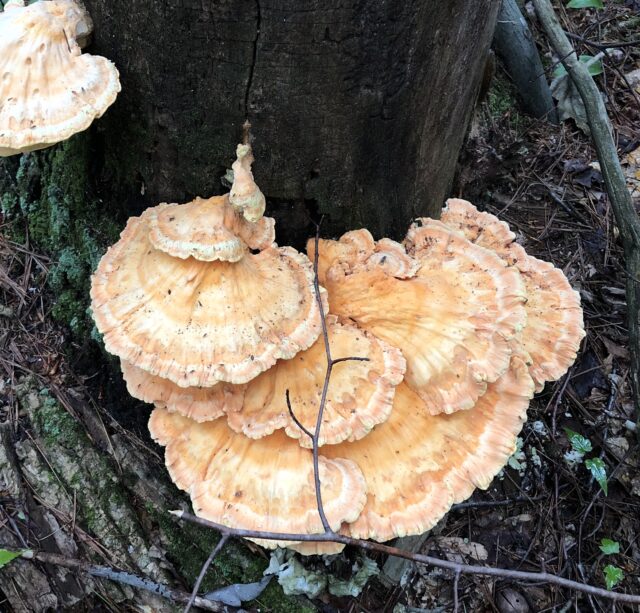
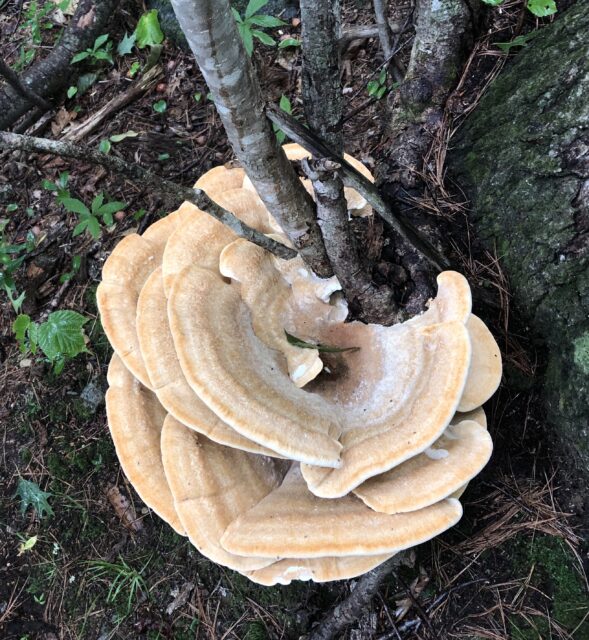
When Not to Consume Your Findings
Finding a Chicken of the Woods is always an accomplishment. If you’ve spotted one, congratulate yourself! However, you will not always be able to consume what you’ve found. Leave behind any COWs with obvious signs of decay, or ones that have become old and tough. Laetiporus Conifericola, the variety of Chicken of the Woods that grows on conifer trees,has been said to cause digestive issues. I have not experimented with this variety, but I wouldn’t recommend trying it.
Additionally, because you are working with a wild mushroom, the safest practice is to cook and eat only a small portion at first and then wait 24-48 hours to see if you have an allergic reaction before having any more.
How to Prepare Your COW
To clean:
- Cut off any old or bug-infested sections. It’s common to find critters living on COWs. I had to remove a piece that had become a slug’s home from my harvest.
- Brush off dirt and wipe off more difficult-to-remove dirt with a wet towel.
- Finally, give you mushroom a quick rinse—but avoid soaking it.
Mushrooms store best refrigerated in paper bags and will last about a week. You can also freeze your COW to cook later. It holds up surprisingly well in the freezer.
Much like real chicken, Chicken of the Woods is extremely versatile. I love to fry mine, but other people sauté, grill, or bake them. No matter what you do, never eat an undercooked mushroom, as this can cause gastrointestinal upset. Make sure they’ve become nice and tender before you serve them. I also encourage you not to over-season your COW, because this mushroom has a special flavor of its own that should be complemented, not covered, with other flavors.
Final Thoughts
Foraging is just one of many ways to seek a deeper connection with your surroundings. If you have never foraged, I hope this article inspires you to give it a shot. If you are already an experienced forager, thank you so much for reading, and I hope you learned something new! Next time you go on a foraging expedition, whether this is your first or your hundredth time, stay safe, stay curious, and have fun!


